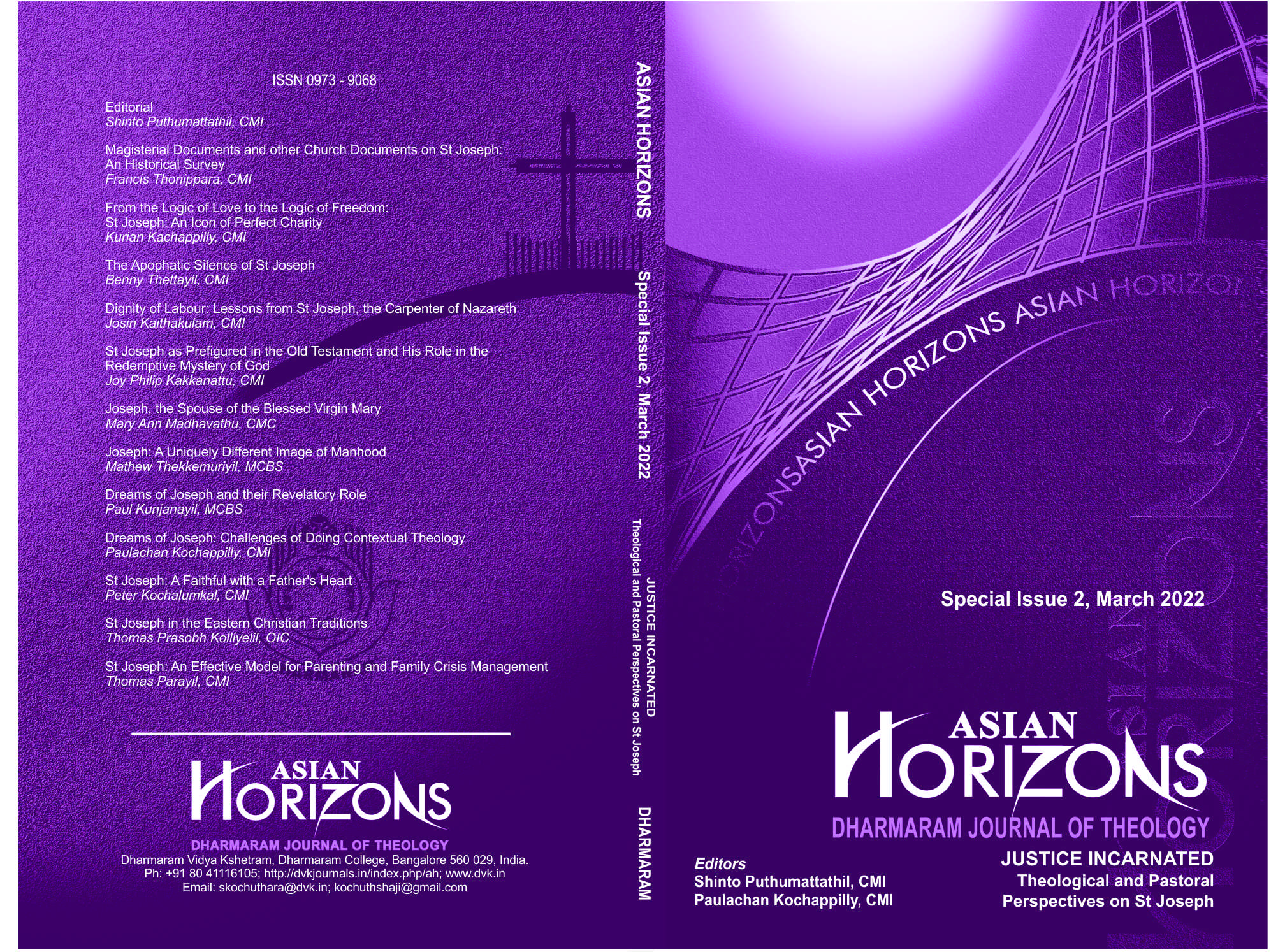ST JOSEPH IN THE EASTERN CHRISTIAN TRADITIONS
Keywords:
Byzantine Liturgy, Cherub of Flesh, East Syriac Liturgy, Guardian of the Hidden Mystery, Son of David, St Joseph in the Syriac Fathers, St Joseph as a Priest, West Syrian LiturgyAbstract
All Oriental Liturgies commemorate and honour St Joseph, the husband of Mary, the Mother of God and the foster father of Jesus in Nazareth. In the Byzantine as well as in the Syriac Traditions, St Joseph is depicted as a man of Alleluia. The contours between Joseph and Herod define the difference between right and wrong praise. As such, the Akathist Hymn in the Byzantine Tradition offers St Joseph as an image of a human being restored to his divine vocation. The Syriac Fathers as well as both the East and the West Syrian Liturgy commemorates St Joseph and seeks his intercessory powers. By comparing Joseph’s act of protecting with the vigilance that Cherub does in paradise, the West Syrian Church Fathers assert that Joseph is a man with divine call. It also affirms that the vocation of being a protector involves all those who protect life and others. The actualisation of the divine call manifests his priestly character, which reveals to us the basic nature of priests. Therefore, the narration of west Syrian Church Fathers on the life of St Joseph depicts him as a model who inspires our Christian journey standing close to Jesus.
References
Alexander Schmemann, For the Life of the World: Sacraments and New York: Orthodoxy, 1973, 120.
Andrew J. Summerson, “St Joseph is a Prophet in the Byzantine Tradition. What can we learn from their devotion?” https://www.americamagazine.org/ faith/2021/03/19/st-joseph-byzantine-tradition-devotion-240278, 19 March 2021.
Jacob of Serugh, Homiliae selectae Mar Jacobi Sarugensis, Vol. I, 316, 9–317, 4 [Homily “On the Pharisee and the Publican,” in Paul Bedjan, ed., Paris—Leipzig 1905–1910, English Translation in The True Vine vol. 9 (1991), 32 (lines 353–370)].
Jacob of Serugh, Nativity 1 FH I, 771–776, 863–864.
Michael Schneider, “Die Verehrung des heiligen Josef in der Ostkirche,” in Der heilige Josef: Theologie, Kunst, Volksfrömmigkeit, hg. v. H.-O. Mühleisen u.a., Lindenberg 2008, 105–112;
Titus John Cheravallil, “St Joseph in the Writings of the West Syrian Fathers,” in Bethany Shabdam 124 (October 2021), Kottayam 51–53.
മലങ്കര സുറിയാനി കത്തോലിക്കാ സഭ: പെരുന്നാളുകൾ [Malankara Syrian Catholic Church: Feasts], Trivandrum: The Synodal Commission for Liturgy, 2019, 14, 38, 39, 42, etc.
മലങ്കര സുറിയാനി കത്തോലിക്കാ സഭ: ഹാശാ ആഴ്ചയിലെ പ്രാർത്ഥനാക്രമം [Malankara Syrian Catholic Church: Divine Office of the Holy Week], Trivandrum: Synodal Commission for Liturgy, 2012, 292.
സിറോ മലബാർ സഭയുടെ കുർബാന. ആഘോഷപൂർവ്വമായ ക്രമവും സാധാരണ ക്രമവും [Order of the Holy Qurbana of the Syro Malabar Church: Solemn and Ordinary Form], Kakkanadu: Syro-Malabar Commission for Liturgy, 20119, 245–253.
Ephrem, “Hymns on the Nativity,” II. 6, in K.E. McVey, ed., Ephrem the Syrian, New York, Mahwah 1989, 77-80.
Jacob of Serugh, FH I, 639–690, in Thomas Kollamparampil, tr. & ed., Jacob of Serugh: Select Festal Homilies, with a forward by Sebastian Brock, 1997 Rome—Bangalore, 37-39, 70–73, 87, 555-564, 613–614, 605–610, 592–593.
Jacob of Serugh, The Descent of the Most High on Sinai, and the Mystery of the Church, HS I, 10,4–6.
Paul Bedjan, ed., Breviarum iuxta ritum Syrorum Orientalium id est Chaldaeorum, 3 Vols., Leipzig 1886–87, vol. 2, 529–539.
Summerson, “St Joseph is a Prophet in the Byzantine Tradition,” https://mci.archpitt.org/liturgy/Christmas_3.html.
Syriac Text in Homiliae selectae Mar Jacobi Sarugensis, P. Bedjan, ed., Vol. V, Paris-Leipzig 1910, 447–446 (Homily No. 165).
Ephrem, “Hymn on Nativity,” II, 13–16; Robert Murray, “Mary, the Second Eve,” 374. Jacob of Serugh also, following Ephrem, holds this double Davidic descent. K.E. McVEY, Ephrem the Syrian, 79 (f. n. 84).

